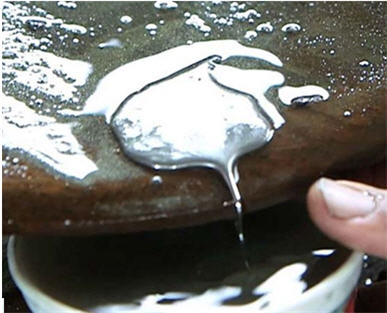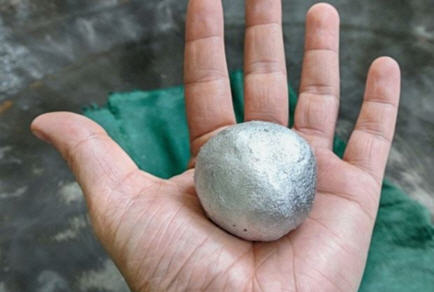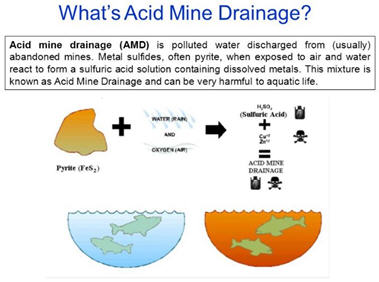As a general rule, the most successful man in life is the man who has the best information
aheadoftheherd.com
Every year millions of small-scale miners toil in the baking sun, collecting and breaking rocks with the goal of extracting small amounts of gold - enough to make a living in some of the most impoverished corners of the world.
Most of these “mines” are illegal and unregulated. The problem of artisanal mining is so widespread, it is estimated as many as 30 million people, many of them women and children, work in this hard-scrabble industry.

Mercury is used to recover minute pieces of gold that is mixed in soil and sediments. Mercury and gold settle and combine together to form an amalgam. Gold is then extracted by vaporizing the mercury. Global Environment Facility
The subsistence miners use
mercury to extract the gold and silver. Mercury bonds well with gold, allowing it to be easily separated from the ore. But the mercury must be burnt off to release the gold from the amalgam, which gives off toxic fumes. Mercury ingestion can cause neurological problems, including the lowering of IQs and genetic defects.

Creating this shiny amalgam of gold and mercury exposes workers to toxic substances and pollutes the environment. CBC.ca
The mercury not only exposes the unprotected workers to poisonous gas, it also gets into the environment, contaminating lands and water supplies, and eventually enters the food chain when digested by fish and game. The Washington-based Natural Resources Defense Council says artisanal miners use about 1,400 tonnes of mercury a year.
“Exposure to mercury threatens our health, with many often irreversible toxic effects. Developing fetuses and young children are most at risk. Mercury pollution also harms wildlife and ecosystems.
Mercury occurs naturally in the earth’s crust, but human activities, such as mining and fossil fuel combustion, have led to widespread global mercury pollution. Mercury emitted into the air eventually settles into water or onto land where it can be washed into water. Once deposited, certain microorganisms can change it into methylmercury, a highly toxic form that builds up in fish, shellfish and animals that eat fish. Most human exposure to mercury is from eating fish and shellfish contaminated with methylmercury, both in the United States and worldwide.
Almost all people in the world have at least trace amounts of methylmercury in their tissues, reflecting its pervasive presence in the environment. Some communities eat significantly more quantities of fish than the general population, and thus may be exposed to much greater mercury contamination. It is estimated that more than 75,000 newborns in the United States each year may have increased risk of learning disabilities associated with in-utero exposure to methylmercury.” EPA
The United Nations Industrial Development Organization (UNIDO) estimates that there are between 10 and 15 million artisanal and small scale gold miners worldwide, including 4.5 million women and 600,000 children.
Artisanal and small scale gold mining is, globally, the largest source of anthropogenic (man-made), mercury emissions. Arsenic and cyanide contamination are other consequences of illegal gold mining.
While small-scale mining and mercury use is a huge problem worldwide, regular mining operations can, of course, also adversely affect the environment. The problem of acid rock drainage (ARD) has plagued the industry for decades. It occurs when sulphide minerals are exposed to air and water, which creates sulphuric acid.

When highly acidic water and dissolved metals leach into the groundwater, it can be harmful to fish and aquatic life. ARD is a concern at operating mines and particularly after mine closure. While advances have been made in preventing ARD and treating exposed mine water, it continues to be a major issue for the industry with respect to leftover tailings and waste piles.
BacTech Environmental (CSE:BAC) was created in 2010 with the goal of addressing both the mercury exposure problem created by artisanal mining and acid rock drainage which has become a negative legacy of depleted mines.

A spinoff of BacTech Mining, which was re-named REBgold, BacTech Environmental was granted a license by REBgold to use its BACOX technology for the remediation of tailings and waste rock left by previous mining operations. Recently, the company added a second application for treating run-of-mine ores.
Also known as bio-oxidation, bioleaching uses naturally occurring bacteria to oxidize sulphides. The bacteria live in reactor tanks and are capable of oxidizing sulphides in as little as five or six days versus years in their natural habitat.
BacTech’s technology is particularly useful for artisanal mining in areas where the miners use mercury to extract arsenopyrite, a mineral that is highly associated with gold. Mercury is only able to extract about 5% of gold found in arsenopyrite, meaning the other 95% of the ore is discarded and wasted.
A recent solution has been to crush and grind the ores followed by flotation to produce an arsenopyrite concentrate thereby eliminating the use of mercury. This process unfortunately produces high grade gold concentrates but also up to 15% arsenic making the product difficult to sell. In Ecuador for example the only buyers of this concentrate are the Chinese, who ship it to Asia for further processing. About 100 tonnes of arsenopyrite concentrate is estimated to leave Ecuador every day bound for the Far East.
“We are sort of a 5% solution. Because we're very good at treating and stabilizing arsenic as part of the process, we've become the answer to the problem. And by virtue of that, we can build our own plant locally and offer more money to the locals for their gold than the Chinese are.” says Ross Orr, BacTech’s president and CEO.
So how does BacTech produce gold and other metals from sulphide ores?
Old tailings are delivered to a flotation plant, where a concentrate containing sulphide minerals and metals is produced. Most of the tailings (95%) are returned to a new, lined tailings pond as inert rock, while the remaining 5% concentrate goes through a series of bioleaching tanks containing bacteria. The bacteria “eats” the sulphide minerals including pyrite and arsenopyrite, making the iron and arsenic water-soluble. The liquor then moves to a thickener where gold and silver are sent in one direction and the liquor with iron and base metals in another. The liquor is then filtered and three non-toxic byproducts are produced: ferric arsenate, gypsum and ferric hydroxide. These are sent back to the tailings pile and the thickener produces gold and silver that go to a conventional metals recovery plant- eventually ending up as dore bars.
“What we do is refloat the tailings and take the sulphides out; the stuff that's causing the problem. As I say, we like to cure the patient as opposed to treating the patient for 50 years,” says Orr.
“If you remove the source of the problem, which are the sulphides, you stop the generation of acid. The benefit is you're getting the contained metals that are associated with the sulphides that helps pay for the process.”
BacTech has so far designed, built and commissioned three commercial plants for acid mine drainage and arsenic stabilization: one in China, one in Tasmania, and one in Western Australia.
But the company decided that it wanted more than a small percentage of revenue from these licensing deals, so it looked around the world for a project that would generate higher returns. The answer was the Telamayu project in Bolivia - one of 26 sites identified by the Bolivian government for mine site remediation. Partnering with COMIBOL, the Bolivian state mining company, BacTech is aiming to build a $7 million gravity flotation plant to extract silver, copper and tin from the Telamayu tailings. The company has identified 500,000 tonnes of material for processing plus another 3.5 million tonnes from an option on a stockpile across the river called the Nuevo Tails.
“We're looking at annual revenues probably in the $25 million range. And cash flow in the upper teens. Let's say it's $15 million. We get 100% of that money until we recover our debt or 18 months, whichever comes first. And it should be the former, not the latter,” says Orr.
“At that stage, after payback, we switch to a 55/45 relationship in their favour.” The project is expected to have a five-year life.
BacTech has conducted drilling on the tailings piles to ascertain metal grades. Assay results from the first 23 holes returned 292 grams per tonne silver, 1,47% tin and 1.07% copper.
Assay results from the last 24 holes of a 57-hole drill campaign, completed in March, showed an average 210.27 grams per tonne silver, 0.93% tin and 1.52% copper. Orr expects engineering on the plant to take three months with construction starting in January at the latest.
Meanwhile BacTech is also working on a project in Ecuador to address the artisanal mining problem there and also the increasing amounts of arsenopyrite being shipped to China rather than being processed in Ecuador.
Building on the work of Dr. Marcello Veiga of the University of British Columbia who implemented the flotation plants that do not require mercury, BacTech has plans to construct a 40 tonne per day bioleaching plant in the area of Ponce Enriquez. The plant will use concentrates purchased from the flotation plants in the area.
The plant economics look good according to BacTech’s projections. Using a gold grade of 49 grams per tonne, a gold price of $1,100 an ounce, and a throughput of 21,000 ounces a year, the plant produces annual revenues of $25 million and a 40% internal rate of return. At $1,200 gold and with grades of 62 gpt at 26,500 ounces a year, revenues jump to $30 million and the IRR to 51%. The flotation plants would be paid 55-60 cents on the dollar.
In June, BacTech
shipped 150 kilograms of arsenopyrite gold concentrate collected from flotation plants in Ecuador for testing at Laurentian University in Ontario. The material will be tested to demonstrate the viability of BacTech’s bioleaching technology for extracting gold from the concentrate as well as a stable ferric arsenate byproduct.
Orr said the testing should take about six months and if all goes well, the plant could be producing gold by the end of next year. After that, the same model could be replicated in other neighbouring countries where artisanal mining is rife, such as Peru and Colombia, giving BacTech the opportunity for multiple recurring revenue streams.
Conclusion:
BacTech is a clean-tech company that has a unique and proprietary technology for addressing two of the mining industry’s most perplexing environmental problems: acid rock drainage and artisanal mining. The company has not only proven that its technology works, through three former plants, but it also has a profitable business model in place. This business model could work both for operating/ abandoned mines that have ARD issues, and for artisanal gold mining regions where the supply of gold ore for bioleaching plants is seemingly endless. The opportunity is there for a series of recurring revenue streams, which should in time translate to a significant increase in market value and shareholder returns.
For these reasons, BacTech Environmental (CSE:BAC) should be on all Ahead of the Herd radar screens. BacTech is definitely on my screen. Is it on yours?
Richard (Rick) Mills
aheadoftheherd.com
Sign up for Ahead Of The Herd’s free
highly acclaimed newsletter.
***
Legal Notice / Disclaimer
This document is not and should not be construed as an offer to sell or the solicitation of an offer to purchase or subscribe for any investment.
Richard owns shares of BacTech Environmental (CSE:BAC) and BAC is an advertiser on his site.